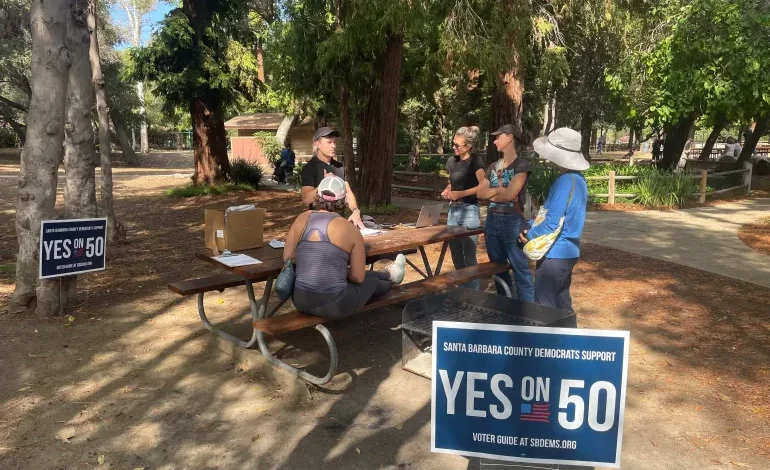Democrats push fight against Trump in California redistricting effort

On a warm Saturday afternoon in the town of Goleta, Aubrie Lugo, a local volunteer, walked down a suburban sidewalk with a stack of flyers.
It was her first time knocking on doors for a political campaign, but she said she felt compelled to get involved in the fight to pass a statewide measure known as Proposition 50.
On a warm Saturday afternoon in the town of Goleta, Aubrie Lugo, a local volunteer, walked down a suburban sidewalk with a stack of flyers.
It was her first time knocking on doors for a political campaign, but she said she felt compelled to get involved in the fight to pass a statewide measure known as Proposition 50.
“It feels like a dire situation,” Lugo said, as she eyed houses festooned with Halloween decorations. “We’re trying to fight the rigging of our democracy.”
Proposition 50 is a measure on the November 4 ballot in California, but its success or failure will have implications for elections beyond 2025.
The measure gives California voters a choice: whether or not to adopt a congressional map designed to net the Democratic Party five additional seats in the United States House of Representatives.
Proponents say the move is necessary to counteract similar Republican efforts elsewhere in the country. Opponents argue that Proposition 50 would strip California Republicans of their voice in Congress.
Both sides have framed their campaigns as a fight to uphold democracy and ensure fair representation.
The outcome of Tuesday’s vote is likely to weigh heavily on the 2026 midterm elections, where control of the House of Representatives is up for grabs.
President Trump’s Republican Party currently holds a slim majority in the chamber, and next year’s midterms are likely to serve as a referendum on his second term in the White House.
To help keep control of the House majority, Trump himself has successfully pushed for partisan maps to be drawn in Republican strongholds like Texas.
Designed as a response, the California ballot initiative has already generated widespread attention, pulling national figures into the state’s fight. Trump has berated the vote as “dishonest”, while his Democratic predecessor, Barack Obama, hailed its importance.
“This vote will have critical implications,” Obama said in a social media post in support of the measure. “Not just for California, but for our entire country.”
A response to Texas
California Governor Gavin Newsom first announced that Proposition 50 would go before voters in mid-August, arguing that Democrats could not afford to “unilaterally disarm” while Republican states pursue partisan congressional districts.
“We’re asking the voters for their consent to do midterm redistricting in 2026, 2028 and 2030 for the congressional maps, to respond to what’s happening in Texas,” Newsom said.
Texas was the inspiration for Proposition 50. In June, reports emerged that the Trump administration was quietly pressuring politicians in the southern state to revamp their congressional districts ahead of the pivotal 2026 midterm elections.
Each district elects its own representative to Congress. And in the House of Representatives, the margins are so tight that a handful of votes could buoy or doom a bill.
Republicans currently hold a narrow majority of 219 seats, just six more than the Democrats.
Fearing Democratic gains in the midterms, the Republican-led Texas legislature ultimately passed a new congressional map that was drawn to disadvantage Democratic voters and gain Republican seats.
Red-leaning states, including North Carolina and Missouri, have also moved forward with their own such efforts.
Many see California’s ballot measure as a test of whether Democrats are willing to counter Trump’s efforts to reshape the electoral landscape, even if it means adopting methods they might otherwise oppose.
“If the Democratic states don’t respond to what Texas did, all of the other Republican states are going to do the same thing,” said Doug Allard, a 77-year-old Goleta resident who voted in favour.










